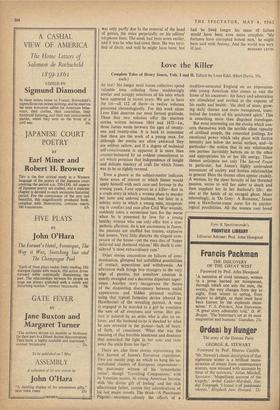Love the Killer
AT last! No longer need James collectors spend valuable time collating those maddeningly similar and scrappy selections of his tales which have appeared in recent years. We are to have the lot—all 112 of them—in twelve volumes presented chronologically. For this work alone Leon Edel deserves our _most fervent gratitude. These first two volumes offer the nineteen stories written between 1864 and 1872—i.e., those James wrote between the ages of twenty- one and twenty-nine. It is hard to remember that these are the work of a young man, for although the stories are often awkward they are seldom callow, and if a degree of technical self-consciousness is apparent it is more than counter-balanced by an evident commitment to art which promises that independence of insight and delicate mastery of craft for which James was to be so rightly revered.
Even a glance at the subject-matter indicates those areas of interest to which James would apply himself with such care and fervour in the coming years. Love appears as a killer—first in a crude story in which a woman plans to murder her lame and unloved husband, but later in a subtler story in which a young man, recuperat- ing in comfort and ease after Civil War wounds, suddenly takes a mysterious turn for the worse when he is possessed by love for a young healthy woman who can only offer him a sym- pathetic affection. As is not uncommon in James, the passions are muffled but intense, explosive but unseen. Very little disturbs the elegant com- posure of the house—yet the man dies of 'hopes deferred and shattered visions.' His death is con- sidered 'a most extraordinary case.'
Other stories concentrate on failures of com- munication, glimpsed but unfulfilled possibilities of contact, separations and withdrawals. An afternoon walk brings two strangers to the very edge of passion, but somehow emotion is quietly strangled and a decorous departure super- venes. Another story inaugurates the theme of the disquieting discrepancy between social appearances and hidden personal realities, using that typical Jamesian device (shared by Hawthorne) of the revealing portrait. A man is engaged to be married to a girl he considers the sum of all sweetness and virtue. Her pic: ture is painted by an artist who is also an ex- lover, and the husband-to-be is shocked by what he sees revealed in the picture—lack of heart, of faith, of conscience. 'What else was the meaning of that horrible blankness and deadness that quenched the light in her eyes and stole away the smile from her lips?'
There are also three stories representing the first harvest of James's European experience. Two are mainly pegs on which to hang his ac- cumulated clusters of European impressions— the passionate witness of his 'sympathetic retina'; though 'Travelling Companions,' with its Venetian scenes, its young American heroine with 'the divine gift of feeling' and her rich affectionate father, carries tiny adumbrations of his last major novels. The third—`A Passionate Pilgrim'—examines closely the effects of a
tradition-saturated England on an impression- able young American who comes to visit the home of his ancestors: his fancy and admiration are stimulated and excited at the expense of his sanity and health: 'the shell of sense, grow- ing daily thinner and more transparent, trans- mitted the tremor of his quickened spirit.' This is something more than disguised travelogue.
But most interesting are the stories which con- cern themselves with the terrible silent rapacity of civilised people, the concealed jostlings for emotional power which take place with furtive intensity just below the social surface, and—in particular—the notion that in any relationship one partner inevitably battens on to the other and appropriates his or her life energy. These themes anticipate not only The Sacred Fount in particular, but James's highly ambivalent assessment of society and human relationships in general. Here the themes often appear crudely. A woman, by the sheer ferocity of her thwarted passion, seems to will her sister to death and then supplant her in her husband's life: she dies at the hands of an enraged ghost. More interestingly, in `De Grey: A Romance,' James uses a Hawthorne-esque curse for its psycho- logical possibilities. All the women ever loved
by the De Grey menfolk have died young: the heroine, in love with the young De Grey, op- poses the curse and goes ahead with her love affair—and this time, the man withers. 'As she bloomed and prospered, he drooped and lan- guished. While she was living for him, he was dying for her.'
What is here streaked with Gothic melodrama is to become a subtler and perhaps more frightening aspect of James's vision of life. For we perhaps tend to forget—charmed by his civilised tone—that for James there was beauty and terror 'in conditions so highly organised'— in civilisation. 'Our imagination is always too timid,' says one of his wiser characters. We prefer not to envisage the possibility of hidden atrocity—but for James it was a perpetual possi- bility. He is at times excessive in his detection of hidden horrors, and then we get melodrama: but if the horror is ever there, he sees it and reveals it. Then we get art.
TONY TANNER







































 Previous page
Previous page